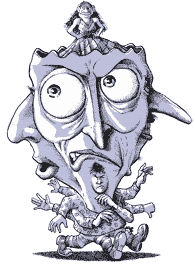Well, not the absolute most annoying, but certain high up there on my list of really annoying things…
I was reading through Time Magazine’s review of the second volume of The League of Extraordinary Gentlemen when I came across this disclaimer at the bottom:
Every time I see something like this is annoys me. You see stuff like this attached to reviews for comics like Sandman or American Splendor and to reviews for animated features like Akira or damn near anything else that comes out of Japan. The first article about Neon Genesis Evangelion I ever read devoted a few whole paragraphs, paragraphs that could have been used in service of actually reviewing the material, to warn parents that Evangelion wasn’t for small children because it was violent and people said “shit.” (And of course, that it’s blasphemous, but that wasn’t really stated explicitly. Instead the writer summed the issue up by saying the series had “mature religious themes.”)
The old cliché (all too true) is that every year a major magazine or newspaper will run an article with the headline: “Bang! Pow! Zap! Comics Aren’t Just For Kids Anymore!” The articles go on to carefully explain that a small group of rogue artists are daring to create a new type of comic book that explores more, and here’s that phrase again, “adult themes.” Nevermind that “adult” comics have been around for decades, it’s always “new” this new phenomenon and it’s always “a small group” of artists and it’s always a big shock that artists who create sequential art aren’t exclusively drawing inarticulate morons in tights.
What bothers me more, though, is when I see graphic novels with stuff like this on the back:
This is, obviously, from the inner flap of volume one of Spiegelman’s Maus but I’ve seen others like it before. The Sandman series that I read had quotes on the covers assuring/warning readers that this was “legitimate literature,” and similar quotes can be seen on American Splendor collections, the collected version of Watchmen, and Ghost in the Shell.
I’ve wondered for a while now if perhaps part of the reason why sequential art has had a hard time finding legitimacy as something other than a “kids’ thing” is because comic fans, artists, and publishers seem to constantly go out of their way to assure people that their adult comics are the exception and not the rule. It may seem strange, but I think that assuring readers that this comic is an “adult” comic does more harm than it does good. By extolling this single comic (say, Maus) as special, one reinforces the notion that comics are for kids.
Consider a shamelessly over-the-top analogy: What idea of African-Americans is reinforced by saying that “this black guy… you know, he’s actually pretty smart.”
I’m not saying that the general public’s refusal to view comics as an all-ages art form is on par with the oppression of minorities but that on a smaller scale the rationale used in my–again, over-the-top–analogy is doing more to trap comics into a box than set it free. The problem of public perception is, I realise, more complex than just this single annoyance, but comic publishers, artists, and reviewers need to stop reminding people that they should view comics in any other way than as a means to an end, a medium..



A good rant on this subject:
http://www.bookslut.com/comicbookslut/2003_10_000736.php
That Maus blurb is awful.
OK, I’ve seen “graphic novels”. I understand there’s a whole world of stuff going on in the field. Even so … I’m sorry, but when I hear the words “comic book” I still think “Archie”. Clearly, I’m not the only one.
If that blurb is from when Maus was first published in book form, then at the time it was necessary.
I’m not sure what edition of Maus I have, but I bought it new from Barnes & Noble last week.
Still, even if it was “necessary” when Maus was first published, how to excuse the blurbs on books like Blankets or other “serious” comics which were published this year?
I don’t mean to be difficult, but the reason people preface stories about non-superhero comics and non-kiddie comics is that is – by far – the majority of what gets creaed and sold. I worked for a distributer in 90’s, and later for a retailer, and even I had a hard time finding anything that didn’t involve Spandex. The blockbuster movies that are tied to comics all involve spandex. Even in bookstores, the majority of th grpahic novels seem to involve spandex, or manga (which generally appears to be the Japanese version of spandex).
At anyrate, I think I cna safely say that if non-standard comics want to sell, they need to sell outside the direct market, and that means reassuring purchasers that they are being a real book, not the spandex covered books they remember form their own childhoods, or that they see thier kids reading – if they see their kids reading them at all – or that they see turned into a movie. Until there are more of these books, that is still going to be a requirement.
first: if comic movies have to be spandex, where does “From Hell” fall in?
second
manga is not a “japanese version of spandex.”
it’s a noun.
like “book”
it’s also as diverse in content as any medium.
sure, the “japanese equivalents of spandex” DO fall into manga format.
but unlike the states, EVERY format is still around.
they still have suspense and crime comics, and those were killed off here by the comics code.
of course they do comedy all over the place. pick one to suit your tastes.
there’s Sports manga, which is about as far from spandex as you can get. Prince of Tennis has as much in common with X-Men as it does with Tolstoy: they’re both printed on paper.